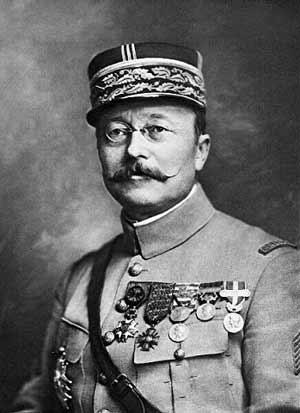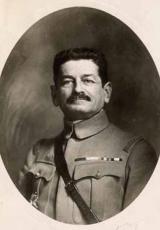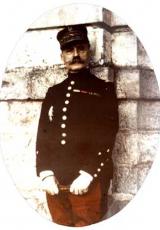Jean Degoutte

Jean-Marie Degoutte enlisted on the 7th March 1887 in the 31st artillery regiment and got into Saint-Cyr in October 1988 with the class of "Great Triumph". He graduated 9th out of 435. Having chosen to join the "Zouaves", he served in Tunisia for four years. A key player in the French colonial venture He asked to take part in the Madagascar expedition in 1895. To get around the refusal of his superiors, he requested three months' leave and joined a Jesuit mission on board a civilian ocean liner. As he was already there when the French expeditionary corps landed, he offered his services to General Dechesnes, who put him under arrest for thirty days. Young officer Degoutte owed his salvation to Colonel Bailloud, the Head of the expedition, who convinced his superiors of the usefulness of his experience and Madagascan language skills. He returned to Tunisia in March 1896 for three years. In 1899 he was admitted to the Upper War Academy, from which he graduated. In 1900, Baillaud included him in the China expeditionary corps. He was cited twice on the corps' order of merit. Returning to North Africa, he became the ordnance officer to the Major General of the Algiers division in January 1905, and then, the following year, to the Major General of the 20th corps.
At the end of 1906, he returned to the Zoaves as Head of Battalion, before joining the headquarters of the Algiers division three years later. From February 1911 to December 1912 he took part in the operations in western Morocco as Head of the Expedition.
On his return to France and promoted to Lieutenant Colonel, he took a course at the Centre for Higher Military Studies. As second in command and then chief of staff of the 4th corps between February and March 1914, he distinguished himself in battle and was appointed Colonel on the 1st November the same year, before becoming an Officer of the Légion d'Honneur on the 10th April 1915. He was appointed Chief of Staff following the attacks of September 1915 in the Champagne region and made Brigade General on the 25th March 1916. In August he took command of the Moroccan troops. The corps distinguished itself in the Somme, in Champagne and at Verdun, feats that earned him two citations and the cravat of Commander of the Légion d'Honneur. As Division General in September 1917, he ran the 21st corps of General Maistre's 6th army. He took part in the Malmaison offensive, which resulted in the fall of the Chemin des Dames, earning him another citation on the Order of the Army. On the 10th June 1918, leading the 6th army, he halted the German advance on the Marne and on the 15th July 1918 he embarked with General Mangin on the attack that marked the start of the French campaign. He liberated Château-Thierry, holding back the Germans on the Marne and the Ourcq and at La Vesle. In September he was designated Major General to the Belgian King. He then led the offensive of Flanders, capturing the Passchendaele crest and taking back the south of Belgium with Belgian, British and French troops. Once the war was over and promoted to Great Officer of the Légion d'Honneur, he was given the responsibility of writing the clauses of the Treaty of Versailles under Foch's supervision.
He was appointed commander of the army of the Rhine in October 1919 and in January 1920 he became a member of the Upper War Council. In 1923 he carried out the occupation of the Ruhr until its complete evacuation in 1925. His qualities helped him reach the rank of Great Cross of the Légion d'Honneur in 1923. He received the military medal in 1928. Remaining active, he influenced the strategic options for the defence of the country at the Upper War Council. The establishment of the line of defence of the Alps occupied his final years.



